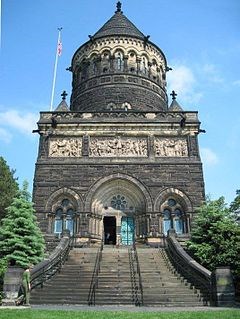Last updated: October 29, 2020
Article
Garfield Rocks! (Part I)

Encyclopedia of Cleveland History
If you have ever driven over the Hope Memorial Bridge (previously known as the Lorain-Carnegie Bridge) in Cleveland or have visited the James A. Garfield Memorial at Lake View Cemetery, you have seen the famous Berea Sandstone, which is a classic stone used in many structures in northeastern Ohio. The Berea Sandstone is well-known due to its extensive quarrying history and its use in many historic structures not only locally, but around the United States.
According to geologists, the Berea Sandstone dates back to the Late Devonian, which was about 359 – 383 million years ago. This was long before the existence of dinosaurs! At this time in the Earth’s history, much of Ohio (as well as much of the interior of North America) was covered by a shallow sea. The quartz grains which largely make up the Berea Sandstone were deposited on the margins of the shallow sea and later lithified to form this sandstone. The Berea Sandstone rock unit can be found in various counties in northeastern and central Ohio and it has been quarried from many of these counties including Erie, Huron, Lorain, Cuyahoga, Summit, Geauga, Lake, Ashtabula, and Trumbull.

Wikipedia
Quarrying of the Berea Sandstone may have started as early as the 1820’s in Ohio, but census records from 1880 date quarries opening in Berea, Ohio in 1830. Many quarries opened in Ohio throughout the 19th century. There may have been 100 or more historic quarries of various sizes that operated in northeastern Ohio, some being so small that they were never even mapped. Quarrying of this stone has since ended in all counties except Erie, where the only active Berea Sandstone quarry is still in operation today. Some of the old quarries are now filled with water and are scenic lakes. Two for example, are Coe Lake and Wallace Lake, both located in Berea, Ohio.
Quarrying of the Berea Sandstone and the rise in the industry began in the city of Berea, the place the rock was named after. The famous Berea quarries actually began as grindstone suppliers and later became dimension stone suppliers (dimension stone is rock that is sawn and split into various sizes and shapes and is used often as building blocks, ashlar veneer, sills, steps, etc.). The Berea Sandstone is also historically known as the Berea Grit, which was the name given to the rock unit in 1870 by a well-known Ohio geologist, John Strong Newberry. Today it is usually referred to as the Berea Sandstone (which is both the formal name of the geologic rock unit and its commercial name in the stone industry).
Many attribute the rise in the stone industry to one man in particular, John Baldwin. In 1828 John Baldwin, the founder of what is known today as Baldwin-Wallace University, moved to the area of Berea, Ohio. Baldwin played an integral part in the development of the grindstone industry here. There are a various versions of the story of how John Baldwin first discovered the Berea Sandstone; thus, the story will differ depending on the source. One source says he discovered a piece of the rock in a river as he was walking home, and the rocks texture and grit led him to believe it would make an excellent grindstone. Others believe that Baldwin discovered the stone while digging a cellar for his house. And still others say that the Berea sandstone was already known by many to be an excellent grindstone, but Baldwin was the first to make a highly successful business out of the this gritty sandstone that had the unique quality of essentially re-sharpening itself (when the surface becomes dull, the worn particles will break off and expose fresh, sharp particles).
Baldwin was innovative and mastered the technique of cutting grindstones. He invented a water powered lathe to cut sandstone slabs into grindstones. A large quarry in Berea was opened by Baldwin and he even built a private railway with oxen-pulled cars that took the stone to the railroad. The industry grew rapidly and many saw dollar signs, so people in Berea quickly starting buying land for the purpose of quarrying. This brought jobs to many people and by the 1870’s, 500 men were employed by the Berea quarries. Berea eventually acquired the nickname the “Grindstone City” and the “Grindstone Capital of the World”.
Written by Lindsay Poluga, Park Ranger, James A. Garfield National Historic Site, April 2017 for the Garfield Observer.
